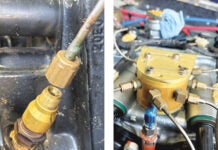Sheet metal repair – that’s what I am talking about. I’ve written a couple of notes in the past few months about repairing the minor skin buckles in our Dream Tundra. It turns out that Dream has re-designed the belly skin, doubling the thickness, then adding another doubler over that. We asked them to double the skin thickness for the chin skin – and when all three part showed up, the number of holes to be matched, and the number of rivets that had to be drilled out and replaced was daunting.
But it had to be done, so we dove in. One six hour day saw all skins removed, and the new ones match drilled and clecoed in place. Another full day of work (minus the coffee hour) saw everything deburred, minor repairs made to bulkhead flanges, the workspace cleaned of old rivet tails, and all bits back in place. Solid riveting was the theme for the next day, as Dream wanted/specified solids in every spot that could be reached. CherryMax’s were measured for, and ordered, for the rest – the places out of reach and visibility.
Solid riveting was finished up and CherryMax pulling was next – and that went pretty quickly. We alternated between having two and three people working in the shop for most of the work, and one was generally working on minor repairs and alignment as well as opening up areas and moving things out of the way for the riveters. Adding antenna and access plate doublers was done to the skins on the bench, before the skins were installed, saving a lot of fiddly work and frustration later.
Day five was finish up – the last few rivets went into difficult spots, and things like door strikers, steel boarding steps, and antennas were re-installed. All that’s left is to replace all access covers and interior panels – but that’s nothing more than what you’d do for any annual condition inspection – which, by the way, we decided to do early, since we had just finished Phase 1 when we took the airplane down for repair, making a good spot in the maintenance cycle to check things very carefully.
So the pile of work that appeared almost insurmountable at the start turned out to be not that bad, once we reconciled ourselves to it. Repair is not that much different from building – you just start by taking things apart. With pre-punched parts, things can go together quickly, because the holes line up – and if they don’t you probably haven’t removed enough of the damaged area.
It’ll be good to get the Tundra back in the air!















